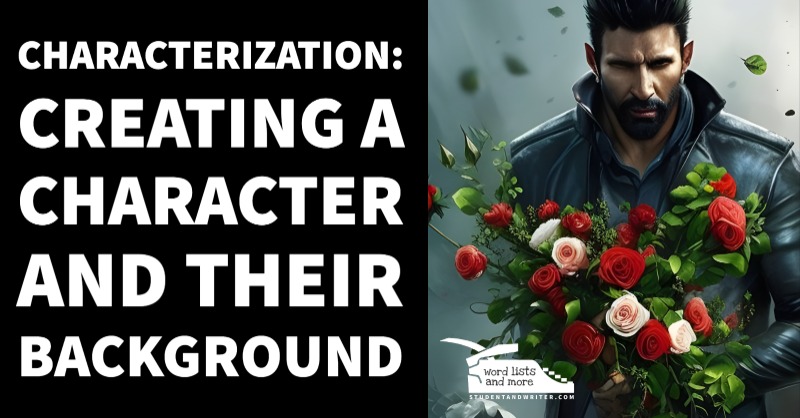Characters are the heart of any story.
Character development is so important in writing fiction. They are the ones who drive the plot forward, and they are the ones who the reader will connect with on an emotional level. That’s why it’s so important to take the time to create well-developed characters with rich backstories.
Creating well-developed characters with rich backstories takes time and effort, but it is worth it. By taking the time to flesh out your characters, you will create stories that are more engaging and memorable for your readers.
Check out my post about negative character traits here, and my other writing posts here.
Here are some things to consider when creating a character and their background:
- Character goals and motivations. What does your character want to achieve? What motivates them to take action? These are important questions to answer, as they will help you shape your character’s personality and behavior.
- Character strengths and flaws. No one is perfect, and your characters should be no exception. Give them both strengths and flaws that will make them relatable and interesting.
- Character backstory. Where did your character come from? What experiences have shaped them into the person they are today? Their backstory will help you understand their motivations and why they behave the way they do. Here are some ideas that can help you create an interesting character:
- Violence and crime. This includes physical violence, such as assault and murder, as well as property crime, such as theft and vandalism. Violence and crime can have a devastating impact on individuals, families, and communities. See my crime/violence blog post here.
- Environmental degradation. This includes polluting the air, water, and land, as well as destroying forests and other natural habitats. Environmental degradation can have a negative impact on human health, the economy, and the planet as a whole.
- Poverty and inequality. When people do not have enough money to meet their basic needs, they are more likely to experience problems such as hunger, homelessness, and poor health. Poverty and inequality can also lead to social unrest and crime.
- War and conflict. War and conflict can cause widespread death, destruction, and displacement. They can also lead to long-term instability and poverty.
- Lack of education and opportunity. When people do not have access to education or job opportunities, they are more likely to be unemployed, live in poverty, and commit crimes. Lack of education and opportunity can also lead to social unrest and instability.
- Addiction and substance abuse. Addiction to drugs and alcohol can lead to a range of problems, including crime, violence, and health problems. Substance abuse can also have a negative impact on families and communities.
- Character personality. What is your character’s personality like? Are they outgoing or introverted? Are they funny or serious? Their personality will help you flesh them out and make them feel more real. Get more ideas for personality quirks here. See more characterization posts here.
- Discrimination and prejudice. This includes treating people differently based on their race, ethnicity, religion, gender, sexual orientation, or other factors. Discrimination and prejudice can lead to marginalization, poverty, and other social problems.
- Greed and selfishness. When people are motivated by greed and selfishness, they are more likely to engage in behaviors that harm others, such as corruption, exploitation, and environmental destruction. Greed and selfishness can also lead to social unrest and instability.
- Kindness: Kind characters are compassionate and caring. They are always willing to help others, even if it means putting themselves out.
- Honesty: Honest characters are truthful and trustworthy. They are always willing to tell the truth, even when it is difficult.
- Courage: Courageous characters are brave and fearless. They are not afraid to stand up for what they believe in, even when it is dangerous.
- Resilience: Resilient characters are able to bounce back from setbacks. They are not easily discouraged, and they always keep trying.
- Optimism: Optimistic characters have a positive outlook on life. They believe that things will eventually work out, even when things are tough.
- Fortitude: Fortitude characters are strong and determined. They are not easily defeated, and they always keep fighting for what they want.
- Gratitude: Grateful characters are thankful for what they have. They appreciate the good things in their lives, and they are always looking for ways to give back.
- Empathy: Empathetic characters are able to understand and share the feelings of others. They are able to put themselves in someone else’s shoes, and they are always willing to help others in need.
Character physical appearance
What does your character look like? What is their hair color, eye color, and body type? Their physical appearance can help you create a visual image of your character in the reader’s mind. There are many interesting ways to describe the physical appearance of characters in writing. Get some more ideas on appearance here: clothes |
Here are a few examples:
- Use similes and metaphors. Similes and metaphors can be a great way to add imagery and creativity to your descriptions. For example, you could describe a character’s eyes as “as green as emeralds” or their hair as “as black as night.”
- “Her eyes were as green as emeralds, and her hair was as black as night.”
- “His skin was as pale as snow, and his lips were as red as blood.”
- “Her smile was as sweet as honey, and her laugh was as bright as sunshine.”
- Use sensory details. Sensory details can help the reader to feel like they are right there with the character. For example, you could describe the way a character’s skin feels, the smell of their hair, or the sound of their voice.
- “His skin felt like warm silk, and his hair smelled like lavender.”
- “Her voice was like music, and her laugh was like a bell.”
- “The way he walked was like poetry in motion, and the way he talked was like a symphony.”
- Focus on the details that are important to the story. Not every detail about a character’s physical appearance is important to the story. When you are describing a character’s appearance, focus on the details that will help the reader to understand the character or that will move the story forward.
- If you are writing a story about a character who is blind, you might focus on describing their other senses, such as their hearing or their sense of touch.
- If you are writing a story about a character who is a fugitive, you might focus on describing their clothing and appearance in a way that helps the reader to understand how they are trying to blend in.
- Be creative and original. There are no rules when it comes to describing the physical appearance of characters. Be creative and original with your descriptions, and use your imagination to bring your characters to life.
- You could describe a character’s appearance in a way that is symbolic or metaphorical. For example, you could describe a character who is struggling with their identity as having “a face that was both familiar and strange.”
- You could also describe a character’s appearance in a way that is humorous or ironic. For example, you could describe a character who is very proud of their appearance as being “the peacock of the room.”
- Check out more posts to help brainstorm your character’s appearance here.
Here are some additional tips for creating well-developed characters:
- Start with a strong concept. What is the essence of your character? What makes them unique? Once you have a strong concept, you can start to flesh out their backstory and personality.
- Be consistent. Make sure that your character’s actions, motivations, and personality are consistent throughout the story. This will help the reader to understand and connect with your character.
- Show, don’t tell. Don’t just tell the reader about your character’s backstory. Show them through the character’s actions, dialogue, and thoughts.
- Don’t be afraid to change your mind. As you write your story, you may find that you need to change your character’s backstory or personality. That’s okay! Just make sure that the changes are consistent with the character’s overall arc.
- Let your characters grow and change. As your story progresses, let your characters learn and grow. This will make them more interesting to readers, and it will also help them to become more relatable.
Intelligent characters
Intelligent characters are able to think quickly and solve problems. They are often good at planning and strategy.
- Give them a strong vocabulary. Intelligent characters use complex words and phrases. They are able to express themselves clearly and concisely.
- Have them solve problems. Intelligent characters are able to think critically and solve problems. They are able to see patterns and make connections that others may not be able to see.
- Have them learn quickly. Intelligent characters are able to learn new things quickly. They are able to absorb information and apply it to new situations.
- Have them be curious. Intelligent characters are curious about the world around them. They are always asking questions and seeking out new knowledge.
- Have them be witty and insightful. Intelligent characters are able to see the humor in situations. They are also able to offer insightful observations about the world around them.
Here are some story ideas that involve intelligent characters:
- A scientist who is working on a breakthrough discovery.
- A detective who is solving a complex crime.
- A hacker who is trying to steal top-secret information.
- A lawyer who is defending a client in a high-profile case.
- A teacher who is inspiring her students to learn.
Brave characters
Brave characters are not afraid to take risks. They are often willing to stand up for what they believe in, even when it is dangerous.
Kind characters
Kind characters are compassionate and caring. They are always willing to help others, even if it means putting themselves out.
Honest characters
Honest characters are truthful and trustworthy. They are always willing to tell the truth, even when it is difficult.
Resilient characters
Resilient characters are able to bounce back from setbacks. They are not easily discouraged, and they always keep trying.
Optimistic characters
Optimistic characters have a positive outlook on life. They believe that things will eventually work out, even when things are tough.
Fortitude characters
Fortitude characters are strong and determined. They are not easily defeated, and they always keep fighting for what they want.
Grateful characters
Grateful characters are thankful for what they have. They appreciate the good things in their lives, and they are always looking for ways to give back.
Empathetic Characters
Empathetic characters are able to understand and share the feelings of others. They are able to put themselves in someone else’s shoes, and they are always willing to help others in need.
- Show them experiencing empathy for others. This could involve them witnessing someone else in pain or distress, or it could involve them putting themselves in someone else’s shoes and trying to understand their point of view.
- Have them make decisions based on empathy. This could involve them choosing to help someone in need, even if it means putting themselves at risk.
- Have them learn from their mistakes. If a character makes a decision that is hurtful to another person, have them learn from their mistake and try to do better in the future.
- Have them interact with people from different backgrounds. This will help them to see the world from different perspectives and to develop a greater understanding of others.
Here are some story ideas that involve empathetic characters:
- A character who witnesses a crime and decides to help the victim, even though it puts them in danger.
- A character who is prejudiced against a certain group of people, but then comes to understand and appreciate them after getting to know them.
- A character who is forced to make a difficult decision that will have a major impact on someone else’s life.
- A character who is struggling with their own problems, but then finds the strength to help someone else in need.
Character Flaws
Make your characters flawed. No one is perfect, and your characters should be no exception. Give them both strengths and flaws that will make them relatable and realistic. Get a lot more ideas for negative character traits here.
- Arrogance: Arrogant characters are overly confident and self-important. They often think they are better than others, and they can be condescending and rude.
- Illegal Activities: For ideas on some illegal activities and hobbies, check out my criminally awesome list for more ideas here.
- Cowardice: Cowardly characters are afraid to take risks. They are often afraid of failure or rejection, and they will often avoid situations that make them feel uncomfortable.
- Meanness: Mean characters are cruel and unkind. They often enjoy hurting others, and they can be manipulative and vindictive.
- Dishonesty: Dishonest characters are not truthful and trustworthy. They are often willing to lie and cheat to get what they want.
- Jealousy: Jealous characters are envious of others. They often feel resentful and bitter towards those who have what they want, and they can be destructive and manipulative.
- Impulsiveness: Impulsive characters act without thinking. They often make rash decisions that they later regret, and they can be reckless and dangerous.
- Stubbornness: Stubborn characters are unwilling to change their minds. They often refuse to listen to reason, and they can be difficult to deal with.
- Negativity: Negative characters are always looking on the dark side. They often see the worst in people and situations, and they can be pessimistic and cynical.
Tips for using character flaws:
Creating characters with strengths and flaws is an essential part of writing a good story. By following these tips, you can create characters that will keep your readers engaged and entertained.
- Make your characters’ flaws believable. Don’t just give your characters flaws for the sake of having flaws. Make sure that their flaws are believable and that they make sense for the character’s personality and background.
- Let your characters’ flaws help them grow. As your story progresses, let your characters learn from their flaws and grow as people. This will make them more interesting to readers, and it will also help them to become more relatable.
- Don’t be afraid to show your characters’ flaws. Don’t just tell the reader about your characters’ flaws. Show them through the character’s actions, dialogue, and thoughts.



